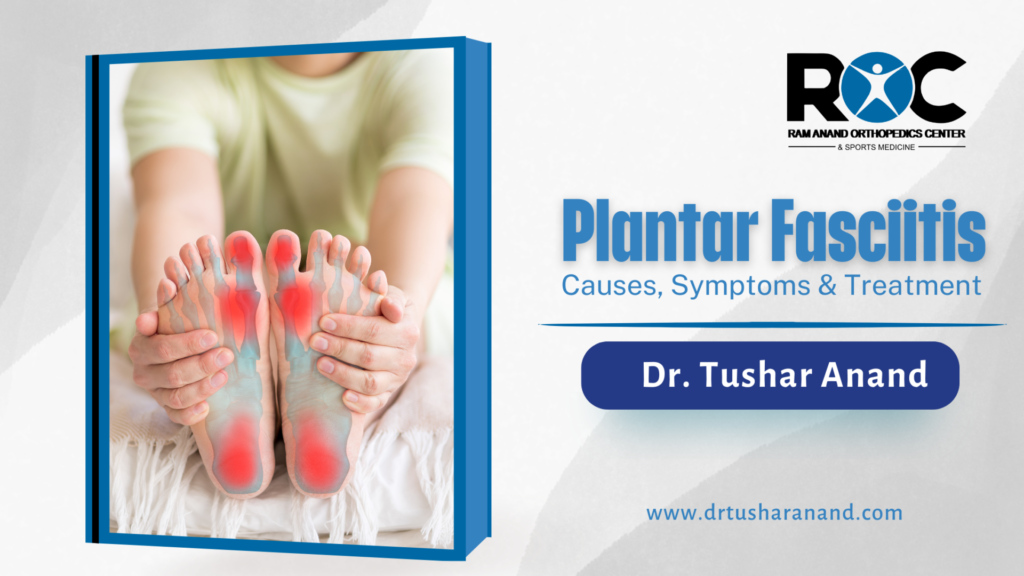Understanding Plantar Fasciitis: Causes, Symptoms, and Treatments
Hello everyone, I am Dr. Tushar Anand, and today, I want to shed some light on a common yet often misunderstood condition known as Plantar Fasciitis. This ailment affects many people, causing discomfort and impacting their daily lives. In this blog, we will explore what Plantar Fasciitis is, its causes, symptoms, and the various treatment options available.
What is Plantar Fasciitis?
It is a condition characterized by pain in the heel and bottom of the foot. It occurs when the plantar fascia, a thick band of tissue that runs across the bottom of your foot and connects your heel bone to your toes, becomes inflamed. This inflammation can result from overuse, injury, or strain.
Causes of Plantar Fasciitis
Several factors can contribute to the development of Plantar Fasciitis. Some of the most common causes include:
Overuse: Activities that put a lot of stress on the heel and attached tissue, such as long-distance running or standing for extended periods, can lead to Plantar Fasciitis.
Foot Structure: People with flat feet, high arches, or an abnormal walking pattern may be more prone to developing this condition due to uneven distribution of weight on the foot.
Age: It is most common in people between the ages of 40 and 60.
Obesity: Excess body weight puts extra pressure on the plantar fascia, increasing the risk of inflammation.
Improper Footwear: Wearing shoes with poor arch support or inadequate cushioning can contribute to the development of Plantar Fasciitis.
Symptoms of Plantar Fasciitis
The primary symptom of Plantar Fasciitis is a sharp pain in the heel, especially during the first steps in the morning or after a period of rest. This pain may subside after some activity but can return after prolonged standing or after rising from a seated position. Other symptoms include:
- Pain that worsens with activity but does not typically continue during it.
- Swelling and inflammation in the heel area.
- Stiffness in the foot, particularly in the morning.
Diagnosis
Diagnosing Plantar Fasciitis usually involves a physical examination by a healthcare professional. They may check for areas of tenderness in your foot and ask about your symptoms and medical history. In some cases, imaging tests like X-rays or MRIs may be recommended to rule out other conditions.
Treatment Options for Plantar Fasciitis
Fortunately, there are several effective treatment options for Plantar Fasciitis. Here are some of the most commonly recommended methods:
Rest and Ice: Giving your foot ample rest and applying ice to the affected area can help reduce inflammation and pain.
Stretching Exercises: Specific exercises can stretch the plantar fascia, Achilles tendon, and calf muscles, providing relief and promoting healing.
Footwear Modifications: Wearing shoes with good arch support and cushioning can alleviate stress on the plantar fascia. Orthotic inserts may also be helpful.
Physical Therapy: A physical therapist can guide you through exercises and treatments to strengthen the muscles in your foot and improve flexibility.
Medications: Nonsteroidal anti-inflammatory drugs (NSAIDs) can help reduce pain and inflammation.
Night Splints: Wearing a splint at night can keep your foot in a flexed position, stretching the plantar fascia and Achilles tendon during sleep.
Extracorporeal Shock Wave Therapy (ESWT): This non-invasive procedure uses shock waves to stimulate healing in the plantar fascia.
Surgery: In severe cases, when other treatments fail to provide relief, surgical intervention may be considered to release the tension in the plantar fascia.
Preventing Plantar Fasciitis
While not all cases of Plantar Fasciitis can be prevented, certain measures can reduce your risk:
- Maintain a healthy weight to minimize stress on your feet.
- Choose footwear with proper arch support and cushioning.
- Incorporate stretching exercises into your daily routine.
- Avoid high-impact activities on hard surfaces.
Understanding Plantar Fasciitis and taking proactive steps can make a significant difference in managing and preventing this condition. If you are experiencing persistent heel pain, it is essential to consult with a healthcare professional for an accurate diagnosis and personalized treatment plan.
For those in the Meerut area seeking expert advice and treatment, I highly recommend visiting an Orthopedic Doctor in Meerut. They can provide comprehensive care tailored to your specific needs.
Remember, timely intervention and appropriate treatment can help you get back on your feet and enjoy a pain-free life. Take care!
By Dr. Tushar Anand
FAQs
The early signs of Plantar Fasciitis often include a sharp, stabbing pain in the heel, especially during the first steps in the morning or after a period of rest. This pain typically decreases with some movement but can return after long periods of standing or rising from a seated position. Other early signs might include mild swelling, inflammation, and stiffness in the heel area. Recognizing these symptoms early can help you seek treatment sooner and prevent the condition from worsening.
Yes, changing your shoes can significantly impact managing Plantar Fasciitis. Wearing shoes with proper arch support and cushioning helps to distribute pressure more evenly across your foot and reduces the strain on the plantar fascia. Avoiding high heels and worn-out shoes that lack support is also important. Orthotic inserts can provide additional support and relieve pressure on the heel, making a notable difference in pain management and recovery.
Recovery time from Plantar Fasciitis varies depending on the severity of the condition and the effectiveness of the treatment plan. For many people, symptoms improve significantly within a few months with conservative treatments such as rest, stretching exercises, and proper footwear. More persistent cases might take six months to a year to fully resolve. Consistency in following the recommended treatment and preventive measures plays a crucial role in the recovery process. If symptoms persist despite conservative treatments, it’s essential to consult a healthcare professional for further evaluation and possible alternative therapies.

